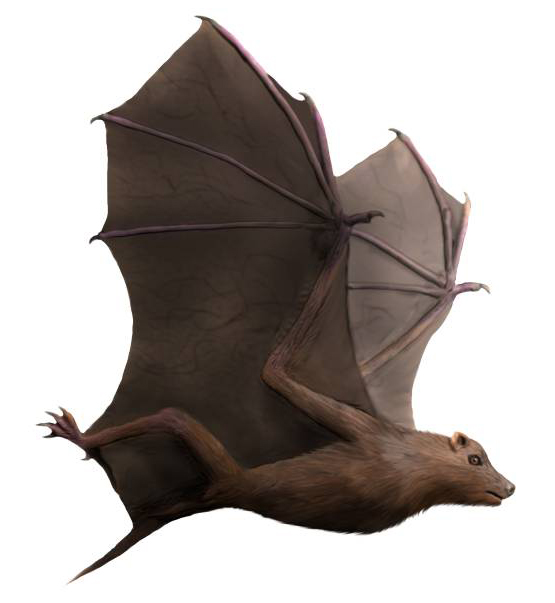Onychonycteris on:
[Wikipedia]
[Google]
[Amazon]
''Onychonycteris'' is the more primitive of the two oldest known monospecific genera of bat, having lived in the area that is current day Wyoming during the Eocene period, 52.5 million years ago.
 ''Onychonycteris'' was unique among bats in that it had claws on all five fingers, as opposed to two or three in all other known species. Its unique limb proportions represent an intermediate between bats and non-flying mammals, with longer hind-limbs and proportionally shorter wings. The aerofoil of ''O. finneyi'' lacks any aerodynamic equivalent among known bats, and this aerofoil likely contributed to an undulating flight style that alternated fluttering and gliding. This flight style may represent both a functional and evolutionary intermediate between gliding and powered flight.
''Onychonycteris'' was unique among bats in that it had claws on all five fingers, as opposed to two or three in all other known species. Its unique limb proportions represent an intermediate between bats and non-flying mammals, with longer hind-limbs and proportionally shorter wings. The aerofoil of ''O. finneyi'' lacks any aerodynamic equivalent among known bats, and this aerofoil likely contributed to an undulating flight style that alternated fluttering and gliding. This flight style may represent both a functional and evolutionary intermediate between gliding and powered flight.
Taxonomy
Two specimens of ''Onychonycteris'' were found in the Green River Formation in 2003, and placed in a new family when the discovery was published in ''Nature'', in February 2008. ''Onychonycteris'' means "clawed bat", in reference to the fact that this animal had claws on all five of its digits, whereas modern bats only have claws on the thumb (in most species) or thumb and index finger (in pteropodids). Thespecific epithet
In taxonomy, binomial nomenclature ("two-term naming system"), also called nomenclature ("two-name naming system") or binary nomenclature, is a formal system of naming species of living things by giving each a name composed of two parts, bot ...
is a tribute to the fossil prospector and preparator who discovered it, Bonnie Finney.
Description
 ''Onychonycteris'' was unique among bats in that it had claws on all five fingers, as opposed to two or three in all other known species. Its unique limb proportions represent an intermediate between bats and non-flying mammals, with longer hind-limbs and proportionally shorter wings. The aerofoil of ''O. finneyi'' lacks any aerodynamic equivalent among known bats, and this aerofoil likely contributed to an undulating flight style that alternated fluttering and gliding. This flight style may represent both a functional and evolutionary intermediate between gliding and powered flight.
''Onychonycteris'' was unique among bats in that it had claws on all five fingers, as opposed to two or three in all other known species. Its unique limb proportions represent an intermediate between bats and non-flying mammals, with longer hind-limbs and proportionally shorter wings. The aerofoil of ''O. finneyi'' lacks any aerodynamic equivalent among known bats, and this aerofoil likely contributed to an undulating flight style that alternated fluttering and gliding. This flight style may represent both a functional and evolutionary intermediate between gliding and powered flight.
Paleobiology
Flight vs. echolocation
''Onychonycteris finneyi'' was the strongest evidence so far in the debate on whether bats developed echolocation before or after they evolved the ability to fly. ''O. finneyi'' had well-developed wings, and could clearly fly, but lacked the enlarged cochlea of allextant
Extant is the opposite of the word extinct. It may refer to:
* Extant hereditary titles
* Extant literature, surviving literature, such as ''Beowulf'', the oldest extant manuscript written in English
* Extant taxon, a taxon which is not extinct, ...
echolocating bats, closely resembling the old world fruit bats
Megabats constitute the family Pteropodidae of the order Chiroptera (bats). They are also called fruit bats, Old World fruit bats, or—especially the genera ''Acerodon'' and ''Pteropus''—flying foxes. They are the only member of the sup ...
which do not echolocate. This indicates that early bats could fly before they could echolocate.
However, an independent evaluation of the ''Onychonycteris'' reference fossil in 2010 provided some evidence for other bone structures indicative of laryngeal echolocation, raising the possibility that ''Onychonycteris finneyi'' possessed the ability to echolocate after all. They did acknowledge that the fossil itself has been flattened by the fossilization process (a 'pancake fossil'), and thus it was difficult to ascertain the exact bone structure and configuration, a fact that still casts a degree of uncertainty on the results of both studies.
It is unknown whether ''Onychonycteris'' had the large eyes of most nocturnal
Nocturnality is an animal behavior characterized by being active during the night and sleeping during the day. The common adjective is "nocturnal", versus diurnal meaning the opposite.
Nocturnal creatures generally have highly developed sens ...
animals as specimens with intact eye sockets have yet to be found. A lack of enlarged eyes would indicate that this species may have been diurnal, solving the problem of how primitive bats evolved flight without the ability to navigate at night using echolocation.
''Onychonycteris'' occurs alongside '' Icaronycteris index'', previously thought to be the most primitive known bat species.
References
{{Taxonbar, from=Q138826 Eocene bats Prehistoric bat genera Prehistoric monotypic mammal genera Eocene mammals of North America Transitional fossils Fossil taxa described in 2008